After years of axed regeneration projects, Hull is finally getting to have a bit of fun with a new pedestrian swing bridge
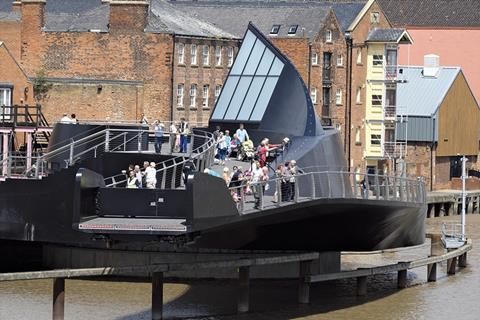
Openable or movable bridges are a common thing. But an inhabited bridge that moves while people are still on it - now that is a rarity. Not so in Kingston upon Hull where a new pedestrian swing bridge with a cafe incorporated at one end of its span has just opened to the public. It is the first bridge of its kind in the UK and, as the architects tentatively claim, quite possibly the world.
This revisionist approach to bridge design is theatrically demonstrated just before the bridge is about to move. Instead of the hazard lights and warning klaxons that intimate knowledge of UK highways health and safety protocol would lead one to expect, a chiming musical sequence starts playing and the bridge’s integrated lights erupt into a playful choreographed sequence. As Jonathan McDowell of bridge designer McDowell + Benedetti Architects puts it: “It’s not a negative warning for people to keep off the bridge; it’s more a positive clarion call for them to approach it.”
“Our key concept was to create a special, unique and memorable place for people to enjoy the riverside,” continues McDowell. “It had to open to accommodate river traffic but we also wanted to create an experience out of its event nature that engaged with people and also incorporated new public spaces for people to eat and sit. It’s a very specific context that has produced a very unique bridge building.”
Bridge over troubled waters
Scale Lane Bridge is located across the River Hull about a half a mile north of its mouth at the much larger River Humber. To its west end lies Hull Old Town, a charming collection of historic cobbled streets and fine civic buildings, particularly a spectacular neo-baroque Guildhall.
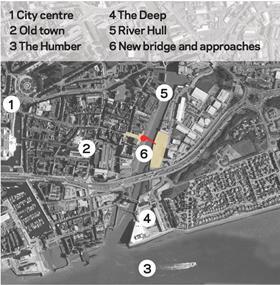
Rather less salubriously, on the east side lies a victim of the recession. The Boom was to be a £100m riverside residential, retail and leisure development. It was put on indefinite hold in 2009 as a result of the credit crunch and is now a temporary free car park by which the local authority pragmatically attempts to lure visitors across the bridge and into the town centre.
The bridge was originally intended to link the new development to Hull Old Town and the city centre beyond. It was also a key component of the Hull City Centre Masterplan, a regeneration vision that included measures to improve connectivity across the river and generate footfall between the various attractions that line its banks. Sadly, this too is currently suspended.
Nevertheless, in a commendable display of municipal foresight, the client body (originally led by Yorkshire Forward and Hull Forward, the regional development agencies abolished after the last general election) decided to persist with the bridge’s construction despite the Boom development’s postponement.
This political context is important to understand why the £7m bridge has been conceived on a considerably more ambitious and expensive scale than one might normally expect a conventional pedestrian footbridge to command. “Of course we could have had a cheaper or simpler bridge” explains Jackie Bolton, of the Homes & Communities Agency that succeeded Yorkshire Forward in its client role, “but we wanted an iconic landmark that would help realise the wider vision for how we wanted to regenerate the riverside and wider city centre areas.”
Hence the launching of an international design competition back in 2005. The brief stated that the bridge had to be openable to maintain clearances for boats. But the key elements delivered in McDowell + Benedetti’s winning scheme, namely the fact that it is inhabited and can be populated while moving, were conjured up by the architects.
Even before opening, the bridge had to navigate choppy waters. Not only was its completion potentially jeopardised by the postponement of the Boom development but construction was delayed by contractual complexities inflicted by the abolition of Yorkshire Forward. The catastrophic floods of 2007, which affected up to 17,000 Hull properties, also didn’t help; as a result, the bridge’s finished height was raised by 15cm.
Nonetheless, construction began in 2009 with the bridge being fabricated off-site in Barnsley and the pieces being transported by lorry to the site for welding and assembly. After intermittent delays, principally caused by the change of client, the finished cantilever span was craned into position last year in 3m slices. Finally, after an eight-year gestation, the bridge officially opened late last month.
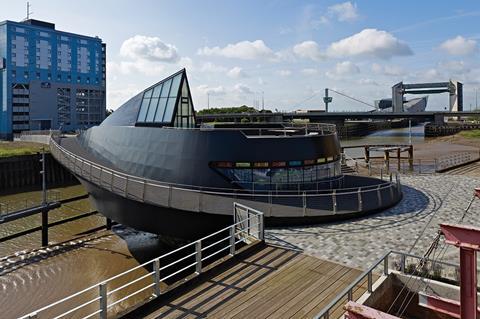
Swing load
The bridge is a comma-shaped structure with the thicker, rounded end resting on the west bank and the narrow end located at the higher east. The west end acts as a pivot from which the entire bridge swings a full 900 southwards when open, dislodging the opposite end from its bank. Reflecting its hinge-like status is the cafe, which is housed in a rotunda structure located at the 18m-wide “eye-let” west end.
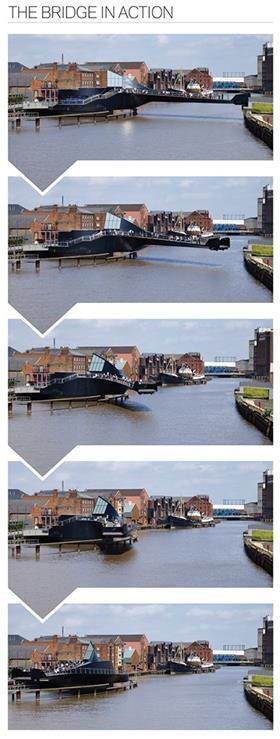
Around the cafe, steps and a ramp swirl upwards to join the higher, narrow curved deck that continues to span 38m across the river. Terraces are incorporated into these inclines onto which tables and patrons of the cafe can spill. Cleverly, the curvature of the cafe also helps accommodate the ramp gradient required to span the 2.1m difference between the east and west ends.
The cafe and bridge superstructure itself is uniformly clad in steel sheeting painted in black, high specification epoxy marine paint. The deck is finished in an epoxy grit system and stainless steel handrails swirl around the bridge edges, a palette and colour scheme which McDowell describes as “appropriately robust” for its demanding inner-city context.
Despite the apparent complexity in specifying a swinging, occupied bridge, McDowell reveals that it was actually the simplest solution within that particular context. “Because the river is tidal, one half of it is essentially a permanent mud-bank while the other is the navigable channel. It made sense to have a simple, rotating swing bridge where the heavy part was pivoted over the mud bank with the lighter span stretched over the water.”
McDowell concedes that there were significant technical challenges in essentially creating a building on water that moves. “There were key performance criteria we had to meet. The deck had to comply with Highways Agency requirements. We had to adopt heavy engineering principles to support the bridge itself and the 1,000 people it is licensed to carry at full load capacity, and yet the bridge still had to be lightweight enough to move and be freely cantilevered. Moreover, we still had to achieve all the things we would on a normal building such as having the drainage connect despite the fact that the structure isn’t static.”
The bridge itself rotates around a 16m diameter reinforced concrete counterbalance, which weighs around 650 tonnes and acts as hinged ballast to the curved, extending cantilevered spine. The cafe over this pivot end is supported on a central pintle and 10 perimeter wheels running on a circular track like a railway turntable. This in turn is laid above a steel ring beam placed over a concrete drum supported on 10 30m x 1.6m piles.
To open the bridge, three electric bevel gear units drive the bridge, which then rotates along the perimeter track. The full opening and closing operation takes around two minutes and during this time only the eastern cantilevered end is closed with a tailgate and its steel stationary alignment wedges withdrawn. The circumference of the western end is large enough for it to remain in permanent contact with its bank throughout the operation and thereby stay open to enable visitors to step on or off as they wish as the bridge slowly revolves.
Hinge benefits
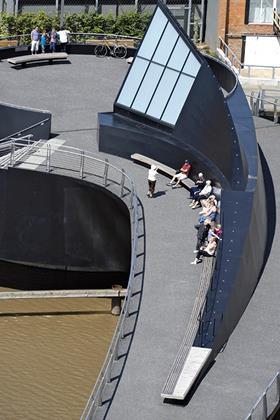
There is an undeniable child-like wonder in seeing big things move. This wonder becomes all the more pronounced when the thing moving is something we are used to seeing stationary, like a bridge or even more quixotically, a building. All these primal fascinations are aroused when watching Scale Lane Bridge glide effortlessly into action. Architecture is far too often an unduly serious affair and it should seek to evoke the simple, celebratory sense present here far more often that it does. This is a consideration that has clearly not been lost upon the bridge’s operators. While the River Hull is not exactly gridlocked with nautical traffic, tidal patterns mean that on average the bridge is required to open up to two times a day. But it can also be opened just for the fun of it to entertain spectators if need be.
Crucially, the bridge also looks like the motion it was devised to perform. Even when stationary, its swirling, circular geometries and streamlined, aquatic profile enable it to convey a sense of speed and movement.
While all its frenzied geometries occasionally lead to some awkward junctions at close quarters, such as the curious church-like glazed pitched roof that tops the rotunda, ultimately it is a finely sculpted object that looks as sleek and nimble as the hull of a speedboat that might well cruise under it.
At present the uniform black cladding also appears a little blank and foreboding when walking on the ramp and terrace around the cafe but it is hoped that these spaces, as well as the landscaped plazas on either side of the bridge, will eventually be vividly animated destinations when a tenant for the cafe is secured and the surrounding developments envisaged for the bridge’s environs are finally constructed.
And it is this wider relationship that forms the bridge’s key role. It is a small but significant cog in a much wider regeneration machine that is yet to be set in full motion. There are signs of it already. The gloriously utilitarian Hull Tidal Barrier looms over the river just yards downstream from the swing bridge and the Deep Aquarium, a commercially successful if curiously deconstructionist piece of Terry Farrell-designed shrapnel is lodged incongruously beside it. A number of museums are also located directly north of the new bridge.
Despite the protracted stalling of the Boom development, one can sense a growing pride and momentum as these new cultural landmarks gently steer the gaze of the city back towards its river. And if this is the case, then it is Scale Lane Bridge’s client body who are to be congratulated for having persisted with this remarkable bridge project even when the bigger development on which it had been hinged was abandoned. They have delivered the infrastructure that will nurture the best conditions to resuscitate the regeneration planned for the site. Like all successful public realm and urban regeneration projects, Hull’s newest bridge has been forged by political will as well as architectural vision.
Project team
architect McDowell + Benedetti
client Homes & Communities Agency
operator Hull City council
original funder/promoter Yorkshire Forward / Hull Forward
main contractor Qualter Hall
structural engineer Alan Baxter & Associates
M&E engineer Qualter Hall
landscape architect Grontmij



























No comments yet